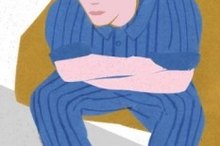A Lump in the Testicle After a Vasectomy
The recovery after vasectomy is usually quick, and most men experience few side effects after the procedure. On occasion, some men may notice a lump in one or both testicles after a vasectomy. Some causes for testicular lumps after vasectomy include sperm granulomas, hematomas and inflammation. Although vasectomy does not cause cancer, a lump in the testicles may be a symptom of testicular cancer.
What Happens During Vasectomy
Before understanding how a testicular lump appears after vasectomy, it is helpful to understand what the vasectomy procedure involves. During a vasectomy, a doctor makes a small puncture or incision into a man's scrotum. He then severs and clips, cuts, ties or cauterizes the vas deferens. Once the vas deferens is severed, sperm are unable to leave the testicles during ejaculation, and a man is no longer able to impregnate his partner.
- Before understanding how a testicular lump appears after vasectomy, it is helpful to understand what the vasectomy procedure involves.
- During a vasectomy, a doctor makes a small puncture or incision into a man's scrotum.
Sperm Granulomas
Symptoms After Prostate Biopsy
Learn More
After the vas deferens has been cut, sperm continue to be produced by the testicles post-vasectomy. Sometimes, sperm begin to leak out of the cut end of the vas deferens after vasectomy, and a small mass starts to grow on the end of the vas. This mass is called a sperm granuloma. Sperm granulomas can sometimes grow large enough to be felt under the skin. Rarely, these lumps become tender, painful or swollen, and must be surgically removed.
- After the vas deferens has been cut, sperm continue to be produced by the testicles post-vasectomy.
Hematoma
A hematoma is another cause of a lump in the testicle after vasectomy. A post-vasectomy complication, a hematoma occurs when blood starts to pool and clump together in the testicles. Other causes of a hematoma include being injured or having certain illnesses or clotting disorders. These lumps appear in about 1 to 6 percent of men post-vasectomy, shortly after the vasectomy procedure is finished.
- A hematoma is another cause of a lump in the testicle after vasectomy.
Post-vasectomy Pain Syndrome
Causes of Testicle and Penis Pain
Learn More
Some men experience long-term, chronic pain after vasectomy. This is called post-vasectomy pain syndrome (PVPS) 2. Post-vasectomy pain syndrome is usually accompanied by tenderness, swelling and inflammation of the testicles. No one is absolutely sure about the cause of PVPS, although some researchers speculate that testicular lumps, like sperm granulomas, cause PVPS. Many men find relief from PVPS only after a vasectomy reversal, while others find medications, nerve blocks and psychiatric treatment to be helpful.
- Some men experience long-term, chronic pain after vasectomy.
- Many men find relief from PVPS only after a vasectomy reversal, while others find medications, nerve blocks and psychiatric treatment to be helpful.
Treating Testicular Lumps
After studying over 10,000 men post-vasectomy, researchers observed that the most common side effects were swelling and pain in the testicles. Some men also reported sperm granulomas, or lumps in the testicles. While testicular lumps are sometimes an indication of a serious problem, the majority of them are benign and can be treated by a doctor. Most men who experience swelling of the testicles find relief with a regular application of heat to the area. Men should report any lumps to a physician to determine the best course of action and treatment.
- After studying over 10,000 men post-vasectomy, researchers observed that the most common side effects were swelling and pain in the testicles.
- While testicular lumps are sometimes an indication of a serious problem, the majority of them are benign and can be treated by a doctor.
Testicular Lump: A Symptom of Testicular Cancer?
Scientists have concluded that vasectomy does not increase the risk of cancer, but a lump in the testicle after vasectomy may be a symptom of testicular cancer. Most often occurring between the ages of 20 and 39, testicular cancer is highly treatable. Men are encouraged to have regular health screenings for testicular cancer in their young adult years, as treatment is most effective when it is started early. Men who notice lumps in their testicles after vasectomy should seek professional guidance to rule out testicular cancer.
- Scientists have concluded that vasectomy does not increase the risk of cancer, but a lump in the testicle after vasectomy may be a symptom of testicular cancer.
Related Articles
References
- Fertility and Sterility; Safety and Effectiveness of Vasectomy; P.J. Schwingl & H.A. Guess; March 2001
- Journal of Andrology; Testicular Pain Following Vasectomy: A Review of Postvasectomy Pain Syndrome; Cory G. Christiansen & Jay I. Sandlow; May/June 2003
- Urology Care Foundation. (2019). What is a Vasectomy?
- Batz D, Greenberg JA. Sterilization in the United States. Rev Obstet Gynecol. 2008 Winter; 1(1): 23–32.
- Cook LA, Pun A, Gallo MF, Lopez ML, Van Vliet HAAM. Scalpel Versus No-Scalpel Incision for Vasectomy. Cochrane Database Syst Rev. 2014 Mar 30;2014(3):CD004112. doi:10.1002/14651858.CD004112.pub4
- Viera AJ. (2019). Vasectomy. O'Leary MP, ed. UpToDate. Waltham, MA: UpToDate.
- American Urological Association. (2015) Vasectomy Guideline.
- Benn P, Lupton M. Sterilisation of young, competent, and childless adults. BMJ. 2005 Jun 4; 330(7503): 1323–1325. doi:10.1136/bmj.330.7503.1323
- Cleveland Clinic. (2020). Vasectomy (Male Sterilization): Procedure Details
- John Hopkins Medicine. Vasectomy.
- Viera AJ. (2019). Patient education: Vasectomy (Beyond the Basics). Richie JP, ed. UpToDate. Waltham, MA: UpToDate.
- U.S. Centers for Disease Control and Prevention. (Updated April 2020). Reproductive health: Contraception.
- Adams CE, Wald M. Risks and Complications of Vasectomy. Urol Clin North Am. 2009 Aug;36(3):331-6. doi:10.1016/j.ucl.2009.05.009
- Sinha V, Ramasamy R. Post-vasectomy pain syndrome: diagnosis, management and treatment options. Transl Androl Urol. 2017 May; 6(Suppl 1): S44–S47. doi:10.21037/tau.2017.05.33
- Patel AP, Smith RP. Vasectomy Reversal: A Clinical Update. Asian J Androl. May-Jun 2016;18(3):365-71. doi:10.4103/1008-682X.175091
Writer Bio
An award-winning medical writer since 1998, Britt Berg, co-author of "Making a Baby," has been published in books, online and in scientific journals. A trained psychotherapist, and an expert on fertility, she holds a Master of Science degree in psychology and a Bachelor of Arts degree in women's studies from Emory University.









